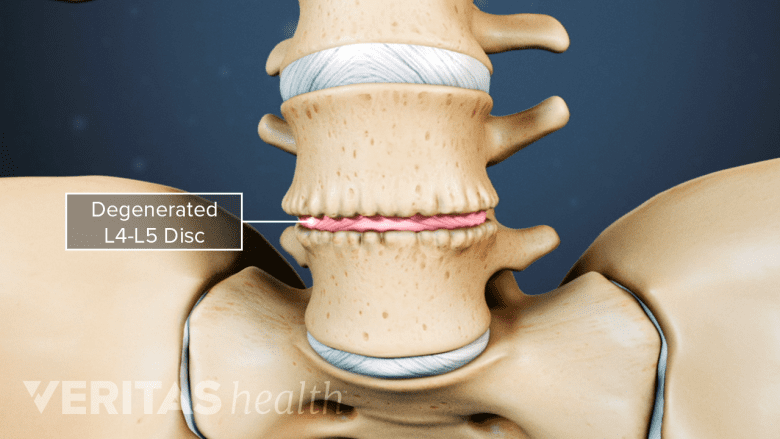Bone spurs are commonly associated with the normal aging process—everyone’s spine undergoes changes with age. Bone spurs can also develop as the result of a spinal condition, typically either spinal osteoarthritis or a degenerated disc.
In This Article:
Spinal Osteoarthritis and Bone Spurs
When the protective cartilage layer of the facet joint deteriorates, it causes spinal osteoarthritis.
Spinal osteoarthritis occurs with degeneration of any bony part of the vertebral column, commonly in the facet joints.
Each vertebra has two sets of facets located in the back of the spine. These facets meet with the facets of the vertebrae located above and below, forming facet joints. The facets move against one another during spinal movement.
For example, the facets are normally coated by smooth, slippery cartilage, so they glide against one another. When the protective layer of cartilage wears away, spinal osteoarthritis develops.
Spinal osteoarthritis causes:
- Bone-on-bone friction at joint interfaces
- Extra pressure on a spinal joint
In response to this added stress, bone spurs develop. Experts believe these bone spurs may be the body’s natural way to:
- Re-distribute weight over a larger surface, protecting the bone1Klaassen Z, Tubbs RS, Apaydin N, Hage R, Jordan R, Loukas M. Vertebral spinal osteophytes. Anat Sci Int. 2011 Mar;86(1):1-9. doi: 10.1007/s12565-010-0080-8. Epub 2010 Apr 10. Review. PubMed PMID: 20383671.,2Wagnac E, Aubin CÉ, Chaumoître K, et al. Substantial vertebral body osteophytes protect against severe vertebral fractures in compression. PLoS One. 2017;12(10):e0186779. Published 2017 Oct 24. doi:10.1371/journal.pone.0186779
- Reduce range of motion, thereby discouraging movements that may cause bony stress
Spinal osteoarthritis most often affects the neck and lower back. It can cause stiffness, pain, and other symptoms. Symptoms are usually worse in the morning, get better after moving around, and then get worse again toward the end of the day.
Spinal osteoarthritis has many possible underlying causes.
For more information, read Spinal Osteoarthritis Risk Factors on Arthritis-health.com
Degenerative Disc Disease and Bone Spurs
Spinal instability from a degenerated disc can cause bone spur formation.
Degenerative disc disease is the wear-and-tear on an intervertebral disc. Discs act as shock absorbers between the spine’s vertebrae, helping protect them during movement and weight-bearing. Each disc has a tough, flexible outer layer and a soft gel-like center (nucleus pulposus). When a disc is damaged, the vertebra above and below it may undergo friction.
How Does a Degenerated Disc Lead to Bone Spurs?
A degenerated disc is likely to lead to instability in the spine, and instability is likely to lead to the type of bone spurs called enthesophytes.
- An enthesis is piece of connective tissue that attaches another soft tissue, such as a ligament, to a bone.
- As intervertebral disc material slowly wears out, nearby ligaments holding vertebra together loosen. The spine loses some stability.
- Instability puts extra stress on the ligaments, causing them to become inflamed. They may also naturally thicken to decrease excess motion and regain some stability.
- Inflammation occurs at the enthesis.
- The inflammation at the enthesis affects the vertebra’s bone growth. Vertebral bone cells are deposited where they would not be normally, causing the enthesis tissue to calcify.
- This calcification forms a bone spur.
Enthesophytes are not just the result of degenerated discs—they can be caused by any injury, chronic stress, or disease that cause soft tissues to become inflamed.
It is important to note that degenerated discs may lead to osteoarthritis, and vice versa. The spine is a complicated structure of bones and soft tissues, and injuries or degeneration in one area can have cascading effects.
The only way to know the underlying cause of back pain is to get an accurate diagnosis.
- 1 Klaassen Z, Tubbs RS, Apaydin N, Hage R, Jordan R, Loukas M. Vertebral spinal osteophytes. Anat Sci Int. 2011 Mar;86(1):1-9. doi: 10.1007/s12565-010-0080-8. Epub 2010 Apr 10. Review. PubMed PMID: 20383671.
- 2 Wagnac E, Aubin CÉ, Chaumoître K, et al. Substantial vertebral body osteophytes protect against severe vertebral fractures in compression. PLoS One. 2017;12(10):e0186779. Published 2017 Oct 24. doi:10.1371/journal.pone.0186779







